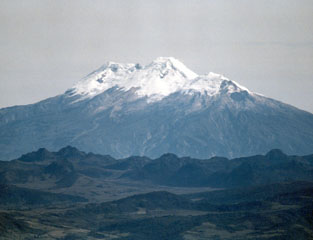Report on Nevado del Huila (Colombia) — 5 November-11 November 2008
Smithsonian Institution / US Geological Survey
Weekly Volcanic Activity Report, 5 November-11 November 2008
Managing Editor: Sally Sennert.
Please cite this report as:
Global Volcanism Program, 2008. Report on Nevado del Huila (Colombia) (Sennert, S, ed.). Weekly Volcanic Activity Report, 5 November-11 November 2008. Smithsonian Institution and US Geological Survey.
Nevado del Huila
Colombia
2.93°N, 76.03°W; summit elev. 5364 m
All times are local (unless otherwise noted)
On 7 November, INGEOMINAS raised the Alert Level for Nevado del Huila to Orange (on a 4-color scale where Orange is the second highest) due to increased seismicity and the probability of ash and gas emissions. During an overflight on 9 November, scientists observed continuous emissions of ash and gas from Pico Central, including from new areas to the S. Resultant plumes drifted SW and W, and ash deposits were seen on the summit. Fissures were evident on the S and SW parts of Pico Central. Evidence of ash and flowing water that originated from the SW fissure was possibly the cause of the Páez river turning grayish during the previous few days.
Based on analysis of satellite imagery and information from INGEOMINAS, the Washington VAAC reported that on 10 November a plume drifted W and WSW. Ashfall was noted in towns 20 km NW.
According to news articles, ash and sulfur dioxide plumes impacted local livestock, rural aqueducts, infrastructure, and rivers. On 11 November, about 20 families living near the Símbola River evacuated because of increased fumarolic activity.
Geological Summary. Nevado del Huila, the highest peak in the Colombian Andes, is an elongated N-S-trending volcanic chain mantled by a glacier icecap. The andesitic-dacitic volcano was constructed within a 10-km-wide caldera. Volcanism at Nevado del Huila has produced six volcanic cones whose ages in general migrated from south to north. The high point of the complex is Pico Central. Two glacier-free lava domes lie at the southern end of the volcanic complex. The first historical activity was an explosive eruption in the mid-16th century. Long-term, persistent steam columns had risen from Pico Central prior to the next eruption in 2007, when explosive activity was accompanied by damaging mudflows.
Sources: EL PAÍS, Servicio Geológico Colombiano (SGC), La Patria, Washington Volcanic Ash Advisory Center (VAAC)

